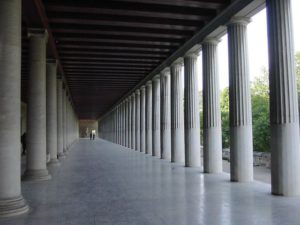
The Stoa of Attalus It is a Hellenistic portico, located in the eastern part of the Agora in Athens. The construction was carried out by Philadelphus Attalus II, king of Persia around 150 BC, in gratitude for the education he had received in that city.
The building was very large like the ones that were built at that time, it measured 116,50 meters long by 20,05 wide. It had two floors, the lower one in the Doric style and one floor in the Ionic style, both floors were linked by two staircases at the ends, its base was rectangular with many columns.
The façade was made of Pentelic marble, the walls were made of limestone from Piraeus, and the roof was tile.
It was a commercial center or the ancestor of the current shopping centers, it had capacity for 41 commercial stores and they had to be rented to the Athenian State.
There were also places for social gatherings and discussions so they didn't have to be out in the cold or in the sun.
Its ruins were discovered in the mid-nineteenth century, it was restored between 1953 and 1956 but nothing was changed, those in charge were the members of the American School of Archeology with funding from John Rockefeller Jr.
The Stoa of Atalo It has in its facilities the Museum of the Agora of Athens.
All the pieces of sculptures and others, found near the Agora are in the Museum of the Stoa.
This building is a symbol of the city and is currently used for important meetings, there was held "the ceremony of signing the enlargement of the EU to ten new countries, Estonia, Latvia, Lithuania, Poland, Czech Republic, Slovakia, Hungary, Slovenia , Cyprus and Malta ”, held on April 16, 2003.